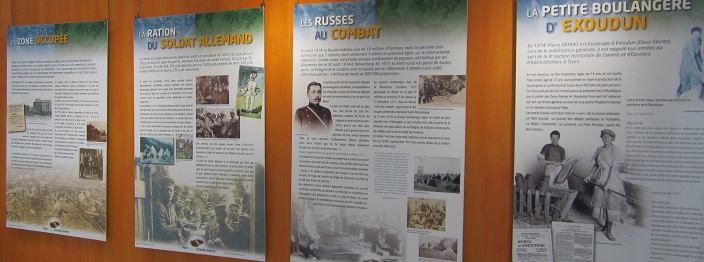Corbie was the second town we visited and is close to Villers-Bretonneux. Corbie has a market on Friday mornings. We went there regularly.
We have been rewarded with Toulouse sausages (saucisses), dried meats, fish, pate, fruit, lentils and beans of various forms, mushrooms and other vegetables. We have yet to get more gastronomically adventurous (horse and blood sausage, pickled tongue etc). As it turns out, 80% of the market is cheap clothes and other haberdashery.
However, the highlight of Corbe for us was the tourist office. This had serious material concerning the week of ANZAC day celebrations, a large display showing their dedication to the War and Bread and a model of the Sir John Monash Education cent er.
er.
The pictures give a pretty good idea. This is serious craftsmanship; these are not play-dough kindergarten creations. If you can do this with flour and a few ingredients, then you can also create other foodstuffs that are exactly what they are meant to be, with no tolerance for error. Its not surprising that boulangeries also have perfect rows of many different cakes in some perfection; I will put a picture at the end. From the land of food.


There were posters about different logistics of baking under fire, German bread, bread for prisoners, and many avocations of bread as essential to the well-being of the soldier, including a poignant one of a meal of bread before going over the top -‘bread before death’ (sort of a last supper or last rites theme). Who else but the French!


Apparently (my translation is highly suspect) French bread is pure and white, while German bread is brown and heavy. I suspect I am missing some deeper symbolic content here, about refinement versus coarseness. 
Indeed as anyone knows, a fresh baguette (baguettes are always fresh, the boulangerie-pâtisserie shop is even open on public holidays) does have some sort of perfection; a soft paper-textured golden skin with a fine soft inner core and the fermented aroma of fresh bread that is lost within a few hours. One can also buy brown or ‘rustic’ baguettes but these are still pretty lightweight and advertised as nouveau!
I miss the heavy-duty grainy bread we had in Amsterdam – a thick slice of that kept you going all morning.
Pâtisseries – sorry in the shade, does not do it justice – but you get the picture, yum!
John Monash Centre
The tourist office also has a model of the $100 million Sir John Monash Centre which is under construction nearby. (sorry about the reflections off the glass protecting it). The imposing front section (model above right) was built in the 1930s (and has many bullet pock marks from WW2). The new Center (currently a hole in the ground) (picture left) will be a very large multimedia education facility directly at the rear of this, to highlight Australia’s role in the conflict.
I have some mixed feelings about all this ‘education’. Most other countries have relatively modest memorials (if you exclude the UK monolith at Thiepval – more about this in ‘Cemeteries and Memorials’). Essentially these are commemorating and respectfully remembering the dead, (and not their deeds) whereas Australia seems to be heavily investing at multiple sites to encourage and nurture something mythic from so long ago. You are left with the questions of ‘why’ and who controls a nations identity?
On the day of writing this i also came across a couple of articles in the Guardian partly reflecting similar concerns, see here, and here – the history wars, part II.
However, I also note elsewhere that the Museum at Peronne does not seem to recognize the leading role of Australia in its (and Mont St Quentin’s) liberation, while (as I understand) over-emphasizing that of the US. Thus some attention to our history may be required. My views on memorials evolve, see the post on Belgium too.




